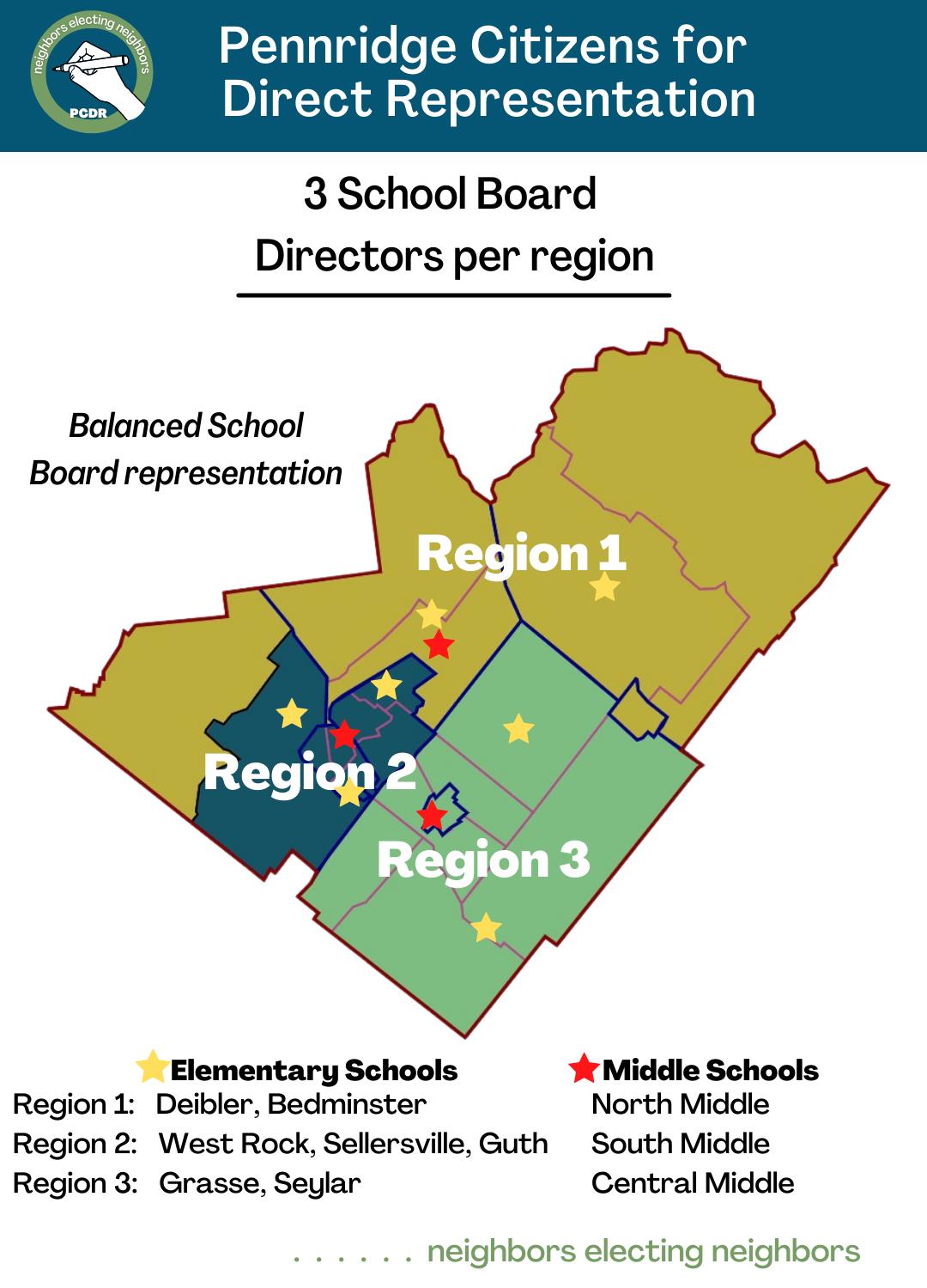Pennridge Citizens for Direct Representation, whose slogan is “Neighbors Electing Neighbors,” believes that district students and schools would benefit from a regions-voting model.
Kevin Foster, a supporter of regions and member of PCDR, explained that a school board director elected via the regions model would have the benefit of being more familiar with situations pertaining to under-addressed issues at the schools within the region. Potentially, regions would ensure greater accountability for elected directors, while offering residents the ability to more easily communicate with and have their voices heard by the school board.
Most Pennsylvanians are unfamiliar with the geographical mechanics that impact school board elections. The Pennsylvania School Board Association describes the three models that dictate how local school districts may elect school board directors: At Large – voters may select any candidate regardless of where they or the candidate reside in the district; Regions – voters may select only candidates who reside in their designated region; or a combination of both. Philadelphia is an exception, as their school board directors are appointed by the Mayor and approved by the City Council.
In many instances the concept of regional voting dates back to when school districts were operated and directed by small municipalities. Historically, and as the population grew, the consolidation – or jointure – of these municipal school districts (usually due to the construction of a centralized high school to serve all local municipalities) resulted in the “regions” and “at large” voting models.
Of Bucks County’s 13 school districts, seven currently have a regions voting model (Centennial, Central Bucks, Council Rock, Neshaminy, Palisades, Pennsbury and Quakertown), while six have an at-large voting model (Bensalem, Bristol Borough, Bristol Township, Morrisville, New Hope-Solebury and Pennridge).
Changing a school district’s voting model isn’t simple. Several things must occur to facilitate the switch and those steps are prescribed by the Pennsylvania Public School Code as follows:
1. A map, outlining the proposed regions within the school district, must be drawn. By law, districts must have three or nine regions. The regions within the district must ensure that: (a) the total population in each region is within a 10 percent margin of the others and (b) the regions must be contiguous and follow, without splitting, the existing electoral precinct boundaries.
2. A petition must be circulated and secure the signatures of district residents in an amount that is equal to or greater than 25 percent of total votes received by the highest vote getter in the last municipal election.
3. A judge must approve the proposed voting model.
PCDR’s plan provides for three regions within the Pennridge School District:
Region One: West Rockhill (Argus), East Rockhill, Bedminster and Dublin with a total population of 17,368
Region Two: Sellersville, Perkasie and West Rockhill (Rockhill) with a total population of 17,295
Region Three: Hilltown and Silverdale with a total population of 17,089
Each region would have three seats on the school board for the required total of nine directors. To date, PCDR has accomplished creating a regions map and is in the process of circulating the required petition.
“I’ve been out canvassing, getting signatures, and talking to folks and they like the idea,” said Ross McLennan, a Pennridge resident and supporter of the project. “I would say at least 80 percent.”
However, others in the district are not as keen about the proposed change. Some do not agree with the prescribed formula mandated by the state’s public school code to enact such a modification, while others have concerns regarding the drawing of the region’s map.
Two Pennridge school district residents addressed the matter. Ada Miller, a former Pennridge school board director, wrote in a Guest Opinion in the Bucks County Courier Times, “This regional model is being promoted as guaranteeing a voice for all residents, but this map is taking many of our voices away.” Scott Bomboy, a member of the Perkasie Borough Council, also used Guest Opinion in the Courier Times to voice his concerns about whether this plan actually will provide better political representation, as well as the process for potentially making these changes.
“[T]he biggest problem has nothing to do with the PCDR. The Pennsylvania state code and court precedents prevent the eight Pennridge municipalities from holding a voter referendum on the issue — the purest form of direct representation,” wrote Bomboy.
PCDR utilized DRA, an open source online tool, to create a “fair and transparent” map. The app allows the user to create geographic drawings by incorporating data applicable to practically any legally prescribed scenario. Two such criteria used by PCDR to create the three regions included an equal distribution of school buildings and an attempt to minimize the splitting of municipalities.
PCDR plans on hosting in-person educational events to detail district residents on the regions voting endeavor, as well as answer questions about the process in the near future. Keep an eye on their FaceBook page for more details.
Regardless of where you stand on the open or regions model for school board elections, local elections matter and there are elections every year. Local and county elections may include: school board director, township supervisor, borough council member, mayor, tax collector, district magistrate and treasurer, to name but a few. The people elected into these positions will likely have more of an impact on your day-to-day life than candidates elected to state or national office.
Are you registered to vote? For more details about voting in Pennsylvania elections visit Voting in PA.






